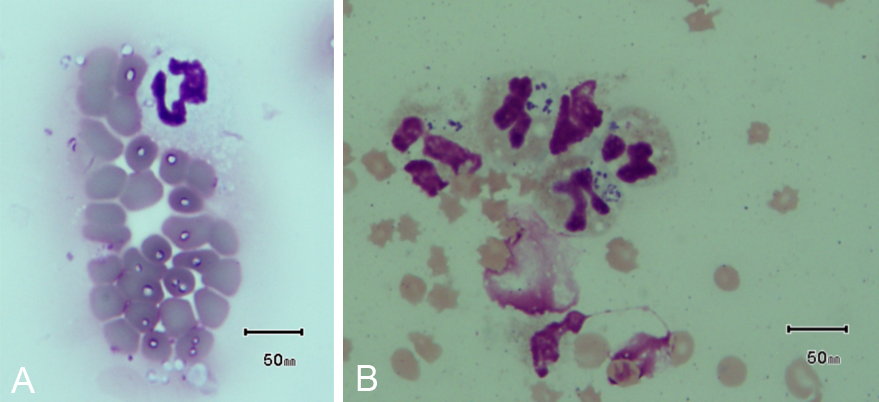31 May 2019
Mastitis, BVD and malignant catarrhal fever are just three of the conditions seen by Axiom Veterinary Laboratories during the spring of 2019.

Photo by Louis Reed on Unsplash
Presented are selected cases from the ruminant diagnostic caseload of Axiom Veterinary Laboratories.
Axiom provides a farm animal diagnostics service to more than 300 farm and mixed practices across the UK, and receives both clinical and pathological specimens as part of its caseload. The company is grateful to clients for the cases presented in this article.
The focus for this newsletter is reproductive, systemic and miscellaneous disease in ruminants in spring 2019.
In cattle, Neospora infection in fetuses and dams was demonstrated by PCR and serology, respectively, in several herds; histopathology of fetal heart and brain is needed to confirm neosporosis as the cause of abortion.
Bovine viral diarrhoea (BVD) viraemia was detected in two fetuses in different herds. In one case, the dam had also strongly seroconverted, suggesting infection in early pregnancy.
High positive titres were detected to Schmallenberg virus in a Holstein-Friesian cow and in two Charolais suckler cows with deformed calves. High positive titres to Schmallenberg virus were also detected in several cows from different herds that had deformed calves.
Salmonella enterica serovars associated with abortion in cattle included S enterica serovar Mbandaka, S enterica serovar Montevideo and S enterica serovar Dublin. Other bacterial abortifacients identified included Bacillus licheniformis (linked to ingestion of mouldy bedding, forage and silage effluent), Listeria monocytogenes and Trueperella pyogenes. A high Leptospira borgpetersenii serovar Hardjo type Hardjo–bovis microscopic agglutination test titre was detected in a Holstein cow bled seven days post-abortion.
Aspergillus fumigatus was isolated from a fetus aborted at between six and seven months gestation in a south Devon suckler herd. Infection is often associated with feeding poor-quality forage or straights.
In sheep, enzootic abortion was reported in more than 70 flocks, diagnosed by both modified Ziehl-Neelsen staining and PCR of placentae. In one flock, enzootic abortion was also tentatively diagnosed on histopathology of a reportedly thickened placenta. In three cases, coinfection with Campylobacter fetus – and, in one case, with Listeria ivanovii – were demonstrated, illustrating the potential role of multiple abortifacients in outbreaks of abortion.
C fetus was isolated from fetal stomach contents in a further 13 flocks. In one Texel flock, weak, ill thrifty lambs were born one to two weeks early; stillbirths also occurred, as did an increased incidence of vaginal prolapses in ewes.
Salmonella enterica subspecies diarizonae abortion was confirmed in seven flocks. In one case, it was isolated from a freshly dead lamb removed from a ewe by caesarean; ewes in the flock had a history of aborting and dying in late pregnancy. This is considered to be a sheep-specific strain, so carrier sheep are the likely source. S enterica serovar Montevideo abortion also was confirmed in an upland flock in Wales.
L monocytogenes was isolated in fetuses in six flocks and L ivanovii was the sole abortifacient isolated in two flocks; abortion outbreaks due to this Listeria species have been associated with eating decomposing plant litter and spoiled feed. Yersinia pseudotuberculosis abortion was diagnosed in one flock.
Toxoplasma abortion was diagnosed by fetal fluid serology or PCR on fetal brain in 12 flocks. High titres to Toxoplasma were detected in aborting ewes in several other flocks.
Viral causes of ovine abortion included Schmallenberg virus – detected by PCR in a brain sample from three fetuses, two of which had arthrogryposis; one also had brachygnathia. Border disease viraemia was detected by PCR in an aborted fetus in one flock and in neonatal “hairy shaker” lambs in four flocks.
Bovine mastitis pathogens less commonly isolated included Pasteurella multocida and Histophilus somni.
P multocida may spread haematogenously or via the lymphatics from the oral cavity and upper respiratory tract; suckling calves and cow-to-cow spread are potential routes of transmission. H somni typically causes a mild, chronic mastitis, but it also has an acute form associated with high fever and blood-stained milk, and a gangrenous form.
Other unusual isolates included Streptococcus gallolyticus, Streptococcus canis and Serratia marcescens. In sheep, isolates included Mannheimia haemolytica and Staphylococcus aureus – considered the most important causes of bovine mastitis.
Among the numerous cases of BVD viraemia, detected through routine screening and diagnostic submissions, was a case of suspected mucosal disease in an 18-month-old Aberdeen Angus with haemorrhagic scour.
Unusually, the animal had a high BVD antibody titre, as well as being strongly viraemic on BVD PCR (cycle threshold value of 22). The results were confirmed on repeat PCR and serology testing, and by BVD antigen ELISA. Typing at the APHA confirmed it as BVD type one.
This was a highly unusual set of results; unfortunately, further investigation was not possible as the animal had died.
One of several cases of malignant catarrhal fever, diagnosed primarily on PCR, was a four-month-old suckler calf with clinical signs including confusion, apparent blindness, nasal discharge, conjunctivitis, photophobia and terminal recumbency.
Intraerythrocytic inclusions consistent with Babesia were detected on an ethylenediaminetetraacetic acid (EDTA) blood smear from a Jersey-cross cow in March that had a history of haematuria and bilirubinuria; ticks were already being seen in the part of Dorset where the animal was grazing.
Inclusions in neutrophils consistent with tick-borne fever were seen in an EDTA blood smear from a dairy cow in a herd where about 10% of cows had exhibited pyrexia and milk drop.

Malignant oedema was diagnosed on clostridial integrated factory acceptance test of muscle tissue from a 12-month-old heifer found dead, with dark muscle, enteritis and fibrinous peritonitis found on postmortem examination.
S enterica serovar Dublin was isolated from the lung of one of a pair of two-week-old dairy calves that developed tachypnoea, dyspnoea, pyrexia and scour, one subsequently dying. Interstitial pneumonia was evident on histopathology, consistent with septicaemia. In a second herd, S enterica serovar Dublin was isolated from cases of meningitis and joint ill in calves.
Listerial meningoencephalitis was diagnosed on brain stem histopathology in two sheep in different flocks; in one case, the sheep were reported to be on mouldy silage.
Sheep scab was diagnosed on microscopy in a tup lamb with a one-week history of pruritus. The affected area was wet and not typical of scab. Seroconversion to sheep scab also was detected in a flock of yearlings.
Chorioptic mange was diagnosed on skin microscopy in a four-month-old golden Guernsey kid, with hair loss and scabs below the carpi of all four legs. The animal had been treated once with doramectin 10 days previously.
Due to the superficial location and feeding habits of the mites, repeat injections of avermectins may be required every 7 to 10 days, particularly with short acting preparations.
Several cases of neoplasia were diagnosed through histopathology:
Fusobacterium necrophorum and T pyogenes were isolated from two different cases of joint ill in young calves, and Mycoplasma bovis was isolated from the joint fluid of one of several cows in a herd with joint infections.
Streptococcus dysgalactiae was isolated from one of several swollen joints in a Friesian heifer and from an infected carpus in a three-week-old lamb. This is the most common isolate from cases of joint ill in young lambs, but is a rare isolate in joint infections in cattle.
A spinal abscess was suspected on histopathology of the spinal cord of one of a batch of four-week-old lambs with hindlimb ataxia or paresis, when a focal area of inflammation was detected within the meninges. Such infections can arise through ascending infection from tail docking or via haematogenous spread, the latter often involving osteomyelitis in a vertebral body.
Y pseudotuberculosis was isolated from a mass on a yearling goat’s neck, from a parotid abscess in a second goat and – together with S aureus – from profuse, foul smelling ocular discharge from a pygmy goat with corneal ulceration and chemosis.
Caseous lymphadenitis (CLA) was diagnosed on culture in a boer goat – one of 20 goats with through-the-fence contact with sheep that had developed facial abscesses. Two goats with mandibular abscesses in different herds were positive for CLA on serology.
Mycoplasma conjunctivae was detected by PCR on ocular swabs from sheep with recurrent conjunctivitis in five flocks. This is considered the primary causative agent of infectious keratoconjunctivitis in sheep.
Struvite urolithiasis was diagnosed in a Hereford steer on barley rolls and hay. Castrated males, with reduced urethral development, on high concentrate rations are at most risk.